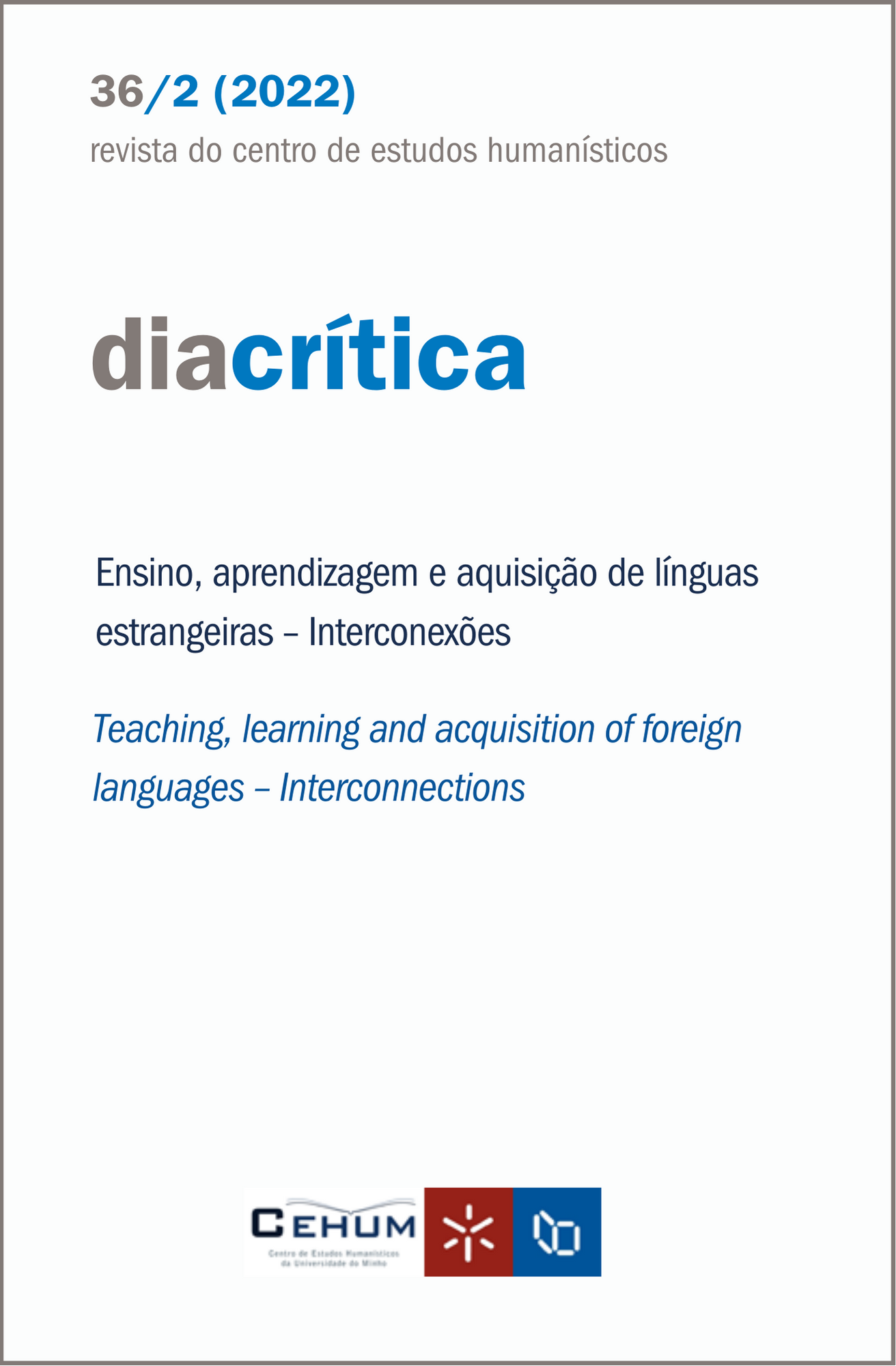Infinitive structures introduced by the preposition de. A romanic vision
DOI:
https://doi.org/10.21814/diacritica.4823Keywords:
Transitivity, Preposition de, Infinitive, Syntax, Romanic languagesAbstract
This text is intended to review the concept of transitivity and, within it, pay attention to the infinitival complement preceded by preposition. In the Romanesque tradition, the transitive verb asks for a complement (called direct) to fill its meaning. That complement, usually, has been presented by traditional grammar as an element attached to the verb without the need for union. During the 19th and 20th centuries that perception has changed, and some languages (such as French, Italian and Portuguese) already classify transitive verbs as direct (without prep.) and indirect (with prep.) and others simply as transitive (Spanish, Catalan, Galician, Romanian), being the indirect, intransitive. However, ancient stages of the language demonstrate that the preposition was common as an element of union. The case of the preposition de preceding the infinitive will be addressed. The issue and the importance of this link will be systematized, now disappeared in many structures, and maintained in others, depending on the languages.
References
Bassols de Climent, M. (2015). Sintaxis latina. Publicacions de la Universitat de Barcelona. (Original publicado en 1956)
Batlle, M., Martí i Castell, J., Moran, J., & Rabella, J. A. (2016). Gramàtica històrica de la llengua catalana. Publicacions de l’Abadia de Montserrat.
Brea, M. (1985). Las preposiciones, del latín a las lenguas románicas. Verba. Anuario Galego de Filoloxía, 12, 147–182.
Campos, J. (1971). La función y flexión del infinitivo latino. Helmantica: Revista de filología clásica y hebrea, 22(67-69), 387–394. DOI: https://doi.org/10.36576/summa.2801
Company, C. (1991). La frase sustantiva en el español medieval. Cuatro cambios sintácticos. Universidad Nacional Autónoma de México.
D’Achille, P. (2008). Breve Grammatica storica dell’italiano. Carocci editore.
Di Tullio, A. L. (2012). Oraciones completivas de infinitivo introducidas por de en el español moderno. In J. Jiménez, M. López, R. Vázquez, & A. Veiga (Coords.), Cum corde et in nova grammatica. Estudios ofrecidos a Guillermo Rojo (pp. 265–276). Universidade de Santiago de Compostela Publicacións.
Egerland, V. (2010). Infinitive, frasi. In R. Simone (Dir.), Enciclopedia dell’Italiano.
http://www.treccani.it/enciclopedia/frasi-infinitive_(Enciclopedia-dell'Italiano)/
García Hernández, B. (1990). Transitividad, intransitividad y causas de su desarrollo en latín tardío. Revista Española de Lingüística, 20(1), 1–16.
Granvik, A. (2007). “De” como marca de infinitivo en el español antiguo. Interlingüística, 18, 1–11.
Institut d’Estudis Catalans (2018). Gramàtica essencial de la lengua catalana. https://geiec.iec.cat/
Kalmbach, J-M. (2008). Intégrer les marqueurs d’infinitif dans la grammaire française. Synergies. Pays Scandinaves, 3, 63–74.
Lleal, C. (Dir.) (s.f.). [DICCA-XV] Diccionario del castellano del siglo XV en la Corona de Aragón.
Martínez García, H. (1992). Algunas construcciones de infinitivo no-subsistentes en el castellano actual. In M. Ariza Viguera (Coord.), Actas del II Congreso Internacional de Historia de la Lengua Española (pp. 631–642). Pabellón de España.
Mattos e Silva, R. V. (1994). O português arcaico. Morfologia e sintaxe. Universidade Federal da Bahia / Contexto.
Meyer-Lübke, W. (1890). Grammatik der romanischen Sprachen (4 Vols). Reisland. https://archive.org/details/grammatikderroma01meyeuoft/grammatikderroma01meyeuoft
Michelucci, P. (2000). Introduction to French Studies. Leçons de grammaire. Department of French – University of Toronto. http://french.chass.utoronto.ca/fre180/LeconsG.html
Real Academia Española. (2009). Nueva gramática de la lengua española (2 Vols.). Espasa.
Real Academia Española. (2014). Diccionario de la lengua española [versión 23.6 en línea]. https://dle.rae.es/
Resende, A. de (1540). De uerborum coniugatione commentarius. Apud Lodouicũ Rhotorigium typographum. https://purl.pt/15169/5/P109.html
Skydsgaard, S. (1967). Análisis sintáctico de algunas construcciones del infinitivo español: preposición/conjunción + infinitivo. In N. Polussen & J. Sánchez Romeralo (Coords.), Actas del Segundo Congreso Internacional de Hispanistas (pp. 611–616). Instituto Español de la Universidad de Nimega.
ATILF. (2012). TLFi : de la Langue Française informatisé. http://atilf.atilf.fr/
Väänänen, V. (2003). Introducción al latín vulgar. Gredos. (Original publicado en 1971)
Vázquez Diéguez, I. (2020). La terminología gramatical en torno a la complementación verbal: puntos de fricción entre español y portugués. In A. R. Carrilho, A. B. Cao, I. Vázquez, P. Osório, & T. Flores (Orgs.), Ao Encontro das Línguas Ibéricas II (pp. 153–181). LusoSofia Press. https://doi.org/10.25768/21.04.06.008
Downloads
Published
How to Cite
Issue
Section
License
Copyright (c) 2023 Ignacio Vázquez Diéguez

This work is licensed under a Creative Commons Attribution-NonCommercial 4.0 International License.










